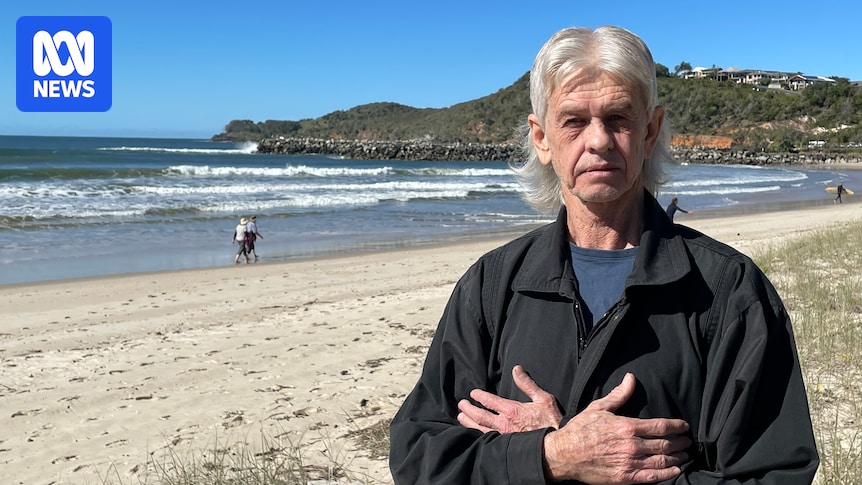A punch and a promise shark attack survivor Craig Ison made nearly 10 years ago has kept him alive.
Warning: This story contains a photo and graphic descriptions of shark attack injuries.
The ex-boxer, who went a few rounds with former world champion Jeff Fenech, reckons a punch on the snout of the great white that bit him at Evans Head on July 31, 2015 stunned it and caused it to let go of his left leg.
While in hospital recovering from his injuries, Mr Ison made a pact with himself: to get over the attack mentally, he would never go surfing again.
“When I was in hospital I was having some really heavy nightmares,” he said.
“I would wake up in a sweat because I was in a dream where I had just lost both my legs.
“I decided there in hospital, that’s it, I’m not going back in the water, and since then I’ve had no trouble.”
Apart from the occasional swim in the ocean, Mr Ison has kept his promise, and it has had a positive effect on his life.
Craig Ison in Gold Coast University Hospital in August 2015. (ABC News: Tom Forbes)
“If I was a young bloke, I’d push through it a bit,” he said.
“But I was 51, so I’d had my fair share of waves and I thought ‘That’ll do me’, and since then I haven’t had any nightmares.”
Another factor helping Mr Ison’s recovery was Bite Club founder Dave Pearson’s intervention.
The first rule of Bite Club, a support group for people who have been bitten or witnessed an attack by an apex predator, is you talk about your experiences.
Whether it was Mr Ison’s attack 10 years ago, or the most recent incident involving a 16-year-old boy at Norries Cove near Cabarita Beach last Sunday, Mr Pearson’s support group has been a much-needed lifeline.
Dave Pearson is one of the founders of Bite Club. (ABC Mid North Coast: Wiriya Sati)
If you or anyone you know needs help:
- Suicide Call Back Service on 1300 659 467
- Lifeline on 13 11 14
- Aboriginal & Torres Strait Islander crisis support line 13YARN on 13 92 76
- Kids Helpline on 1800 551 800
- Beyond Blue on 1300 224 636
- Headspace on 1800 650 890
- ReachOut at au.reachout.com
- MensLine Australia on 1300 789 978
- QLife 1800 184 527
Mr Pearson said attacks like this would have a ripple effect on the community, particularly rescuers, fellow surfers, first responders, and even people who use the beach regularly.
Like many, Mr Pearson watched graphic footage of last Sunday’s attack on social media that showed the shark swimming right into the shallows as surfers helped drag the teenager to safety.
It reminded him of his own attack by a 3-metre bull shark on the Mid North Coast of NSW in 2011.
“The shark followed me all the way to the beach, and that also happens a lot more than people realise,” he said.
Mr Pearson said, initially, the teenager might feel fortunate to have survived the attack, but his longer-term recovery could be plagued by other problems.
“Usually, the mental side of things doesn’t kick in until some time afterwards. Usually, it is a period of weeks, or months before you really start to feel the full effects of the post-traumatic stress,” he said.
Bodhi McDonald, who saw the shark 10 minutes before it attacked, and Tweed councillor James Owen at Cabarita on Monday. (ABC North Coast: David Kirkpatrick)
Bodhi McDonald was one of the surfers in the water that day. He is also the same age as the teenager who was attacked.
“It took us all by surprise because it is such a horrific event to take place at our beach that we surf at nearly every day,” he said.
Thiago Collela gave first aid to the teenage shark attack victim at Cabarita. (ABC North Coast: Emma Rennie)
Queensland volunteer lifesaver Thiago Collela was also there on the day of the attack and helped an off-duty paramedic apply a tourniquet to stem the bleeding.
“The laceration on his bicep was really, really bad. You could see all of the muscle and bone,” he said.
Mr Collela is a fellow surfer and said the shark attack had made him a bit nervous about getting back in the water.
“It is always good to have people around you when you are surfing because in those cases they can help you,”
he said.
Mr Pearson said the Bite Club covered attacks not only by sharks but lions, bears, and crocodiles. It was also open to anyone who had witnessed an attack.
“Those people who are responsible for saving your life can go through quite a lot of trauma afterwards because they second-guess what they did and didn’t do,” he said.
Cabarita Beach has drum lines to deter sharks. (ABC North Coast: Chris Kimball)
The attack at Cabarita happened in an area covered by the NSW Shark Management Program and the deployment of SMART drum lines. There are four drum lines in the Norries Cove area.
These drum lines used baited hooks and GPS communications to intercept and tag sharks near beaches.
